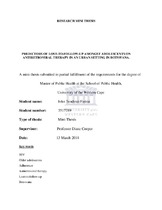| dc.description.abstract | There has been a recent increase in the proportion of adolescents living with HIV being enrolled
on anti-retroviral therapy (ART) in Botswana, with more than 90% accessing this life saving
therapy. A significant proportion become lost-to-follow-up (LTFU) from the ART care,
reversing the initial gains attained. The factors associated with lost-to-follow-up in this
vulnerable HIV positive adolescent population in Botswana are generally unknown, as most
studies on this subject are on the adult population.
This study investigated the rate and factors associated with lost-to-follow up amongst middle and
late adolescents (15-19 years) on ART at Botswana-Baylor clinic in Gaborone, Botswana. The
center provides comprehensive HIV prevention, treatment and psychological services to children
and adolescents living with HIV. The research intended to assist HIV program managers to
retain adolescents in care, which is vital in reducing morbidity, mortality and also new HIV
infections amongst this population. The research design was an observational comparison
between those LTFU on ART and those retained on ART. Simple random sampling was used
and the study had 133 of those LTFU and 133 of those not LTFU. Data on the risk factors were
retrospectively extracted from patient records stored in a data-base at the clinic. The data were
analyzed using Epi-info 7 statistical software to determine if there were any statistically
significant factors associated with lost-to-follow-up amongst adolescents on ART. The study
involved a vulnerable population who are HIV positive and a proportion who were less than 18
years. However minimal harm was expected as this was a record review and data was
anonymized prior to analysis. Ethical clearance was given by the Botswana Baylor Clinic Ethics
Committee and the University of Western Cape Biomedical Ethics Research Committee.
The LTFU rate in the clinic amongst adolescents (15-19 years) was 4.6%. Using bivariate
analysis there were significant associations between LTFU and the following variables: CD4
count (prior to LTFU), detectable viral load, past history of Tuberculosis, PI-based ART regimen
and suboptimal adherence. However after multivariate analysis, only detectable viral load and
suboptimal adherence were independent predictors of lost-to-follow-up. Middle and older
adolescent patients lost-to-follow-up were 5 times more likely to have a detectable viral load and
4 times more likely to have suboptimal adherence than those not lost-to-follow-up. The findings
in our study will assist clinicians at the Baylor-Botswana clinic identify adolescent patients needing extra support to be retained in care and improve clinical outcomes. More studies of this
type are needed in solely public sector clinics in Botswana and regionally, as there is a sizeable
population of people living with HIV in middle and late adolescents in which lost-to-follow up
appears to be greatest. | |

